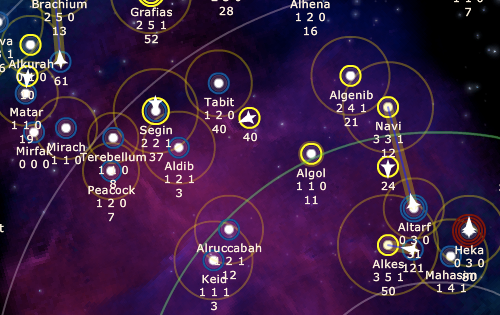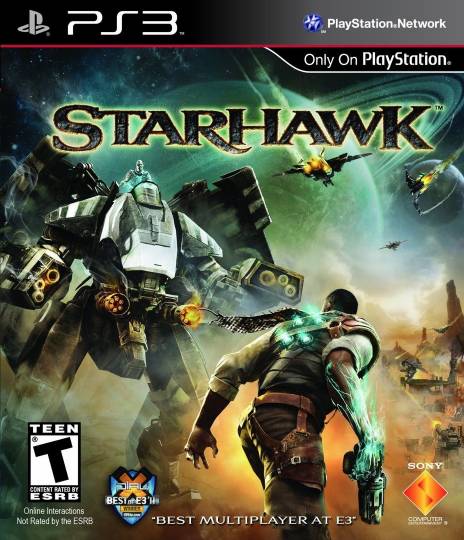
These past few weeks I’ve been fighting a pitched interstellar war against fellow game bloggers Matthew Burns, Ben Abraham and Michel McBride-Charpentier. Early in the game I had a long-standing alliance with Ben, and we peacefully teamed-up to take out our red neighbour “Dr Dinosaur”. I sold weapon technology to Matthew in his distant campaign against Michel, who was the winning player at the time. As I rallied my troops on my Eastern border to confront the next enemy, Ben and Matthew launched a treacherous surprise attack on my unprotected plank. I’m making a last stand on four planets now, while Ben and Matthew turn on each other for complete control of the galaxy.
Neptune’s Pride is a browser-based multiplayer strategy game that falls somewhere between Galactic Civilizations and Risk. Eight empires fight to be first to conquer half of the galaxy’s ~180 stars. While the game ostensibly progresses in real-time, moving a fleet from one planet to another takes about 16 hours (before speed upgrades) and your economy only produces funds once a day. Thus players only need to check the game a few times a day, a style sometimes referred to as “sporadic play”.
What’s even more interesting about Neptune’s Pride is the high level of strategic abstraction, closer to a board game than a video game. There is only one type of fighter ship and one currency. Planets can be developed for economy, industry or science. Science slowly improves fleet weapons, speed, range or scanning. The diplomatic options are equally stark: players can message each other (privately or publicly) and send resources/technology. This means that there are no game mechanics governing alliances, trades, borders, etc. Interstellar relations are therefore forged on trust, cunning and strategic treachery. Playing with friends adds an extra dimension of political deviousness: are they going to check Neptune’s Pride before going to bed, or can I launch a sneak attack overnight?

While my performance in the last match was nothing to brag about, I feel I’ve mastered Neptune’s Pride sufficiently to impart some wisdom to new players.
Firstly, understand how the combat system works. There are no random elements or dice rolls in Neptune’s Pride. The defender always strikes first, and kills a number of enemy ships equal to their weapon tech level plus one. The attacker then kills a number of enemy ships equal to their natural weapon tech. This goes back and forth until one side runs out of ships. There’s therefore no need to guess the outcome of a battle; you can compute the results beforehand, and only commit if the outcome is favourable.
Remember that the defender has a double bonus: first strike and extra weapon damage. Use this to your advantage! Try to leave a one ship garrison on every planet you own. If the enemy tries to land there, they’ll lose 5+ ships and you’ll only lose one. This kind of attrition can really slow a raiding party.
The four technology upgrades are not equal in worth. Namely, the range upgrade isn’t very good. Early in the game it can be handy to throw a level or two into range in order to reach outlying stars or save travel time by cutting across diagonals. You might assume that later on it would also be handy to blitzkrieg your way behind enemy lines. Unfortunately, this isn’t the case. If the enemy can see your fleet, he or she can also see its destination. Your opponent will have plenty of time to organize their defences for your arrival. Your upgrade time is better spent on weapons, speed and occasionally scanning.
On the topic of science upgrades, I learned the hard way that it isn’t worth being the tech leader. At the height of my empire, I had invested in 5 more scientific research facilities than any other player. However, I only had a negligible advantage in terms of fleet technology. The reason was that other players were more pro-actively trading technologies. They were therefore upgrading their fleets at a fraction of the cost and nullifying my advantage. It’s simply more strategic to barter, even at the risk of arming your enemies.
Those are all the strategic revelations that I managed to gleam from my one and a half games of Neptune’s Pride (you might also learn a thing or two from Rock, Paper, Shotgun’s play diary). If you’re interested in giving the game a go yourself, I highly recommend dragging a friend or two along for the match. I’ll be sure to put out a call on Twitter for the next campaign!





March 15th, 2010 at 3:26 pm
Joe Tortuga and I are interested in putting together one of the epic premium games. Any interest?
March 15th, 2010 at 5:16 pm
The screenshot at the top is my most proud achievement in that game. I felt like a master – a dirty, backstabbing master of deception.
And I still don’t feel like I completely understand the combat.
March 15th, 2010 at 4:52 pm
One currency, one ship, a dozen players, a bunch of stars, real time sporadic play over a few weeks, no enforced diplomacy, deterministic combat and very simple technology mechanics… this brings back memories of the old Skotos Tech browser game Galactic Emperor: Hegemony. They sound so similar, in fact, that I wouldn’t be surprised if Neptune’s Pride was at some point directly inspired by the older game. It’s moving in on long vacated territory, however: Hegemony has been essentially dead for years. I had a lot of fun with Hegemony back in the day, so I’m pleased to see another game occupying that space.
The number one biggest difference that I can see without playing it is that in Neptune’s Pride, you appear to be able to see enemy ships that are moving between planets, which is a huge strategic difference. In Hegemony, you only saw enemy ships when they arrived at your planets or clashed with your fleet, and your only intel about enemy planets was who owned them. Many maneuvers in Hegemony were about control of information about your fleet size and position. You could, for example, attack a planet with a wave of fifty ships, hiding two hundred more in a second fleet scheduled to arrive only one minute behind the first wave — the cost was that you would lose more ships if your first attack wave wasn’t more than twice the size of the defense fleet.
Ship production may have also been a fair amount different, but I can only speculate. Each factory produced one ship each day, and cost a fixed investment; thus, factories were most useful when purchased early in the game, since they would pay for themselves many times over early on, and produce only a few ships if purchased late. Factories were extremely valuable, and losing a factory world was a huge blow to any player, while capturing one was a strategic coup.
Range was useful in Hegemony if you needed to vault over neutral territory, or a defended border. Because ship moves were invisible, long range fleets would let you make more shocking sneak attacks, and penetrate deep into the enemy empire. Making a direct line for a known or suspected enemy factory world was a high risk tactic that sacrificed the potential income from capturing territory for the chance to end a war in a few short moves. If the enemy correctly anticipates the location of your fleet’s next target, they could also invest a large amount of money to outright destroy that planet, completely wiping your fleet out the instant it arrives at the destroyed world.
One interesting thought is that the most successful Hegemony players over the long run were always those known for both strong play and consistent diplomatic integrity.
March 16th, 2010 at 1:42 am
And Ben called me paranoid when I said something about you and Burns sharing tech. Hah.
Diplomacy is crucial. I lost because I didn’t communicate quickly enough with another strong player at the far end of my empire (n01d). We both had enemies we needed to focus on but he chose to send a large fleet at me even though he had no hope of winning. What it did do was tie up one of my own fleets of ~100 ships so it couldn’t repel the main threat at my other border. I don’t think he understood the intricacies of galactic strategy because weakening me wasn’t in his best interests. The most important part of diplomacy is constantly reassessing your neighbours and figuring out which you need weak and which can be allowed to become a bit stronger.
March 16th, 2010 at 1:48 am
“And I still don’t feel like I completely understand the combat.”
It’s just math with every variable known. I was working out every battle on paper ahead of time, but it’s super easy with that calculator now. It makes defeat all the more sour when you calculate victory and then have 100 ships removed from the equation because of some dumb move in the armpit of the galaxy. ugh. Anyway, fun game. The pricing model sucks though…should be way cheaper to start premium games.
May 6th, 2010 at 6:57 pm
[…] diplomacy/risk-like online flash game. Lots of people have reviewed it, some of them discussing obvious […]
November 25th, 2010 at 3:31 am
It’s a really good game. I like the tips you added here, but you have to be situationally aware of what’s going on before committing. I’m in the middle of a game where most of my competitors left leaving just 2 other players to play with.
I found out very quickly that no one was willing to trade tech because of how quickly people switched sides to take advantage of the situation. As exploration died out and upgrading industry (for ships) became quite expensive, a “tech” race began where we all tried to stay ahead of each other in the weapons category.
This game is brilliant. No randomness involved it’s a pure skill, pure strategy game and I absolutely love it!